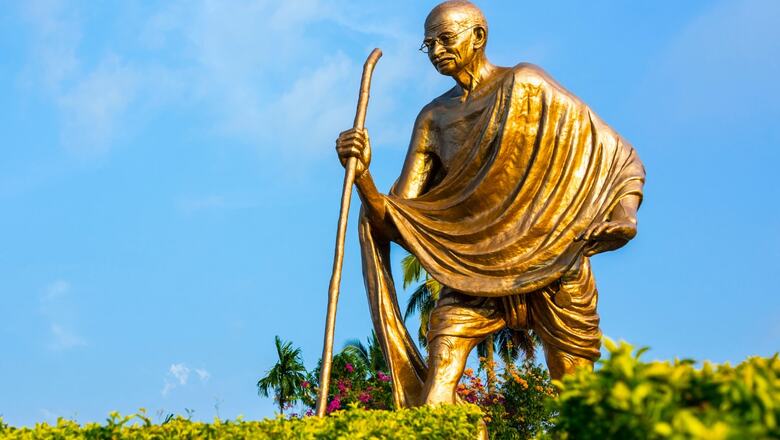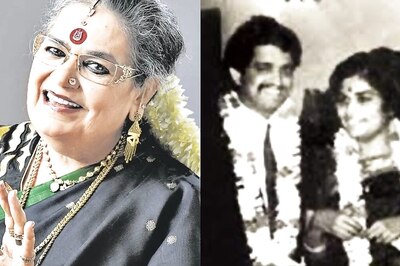
views
Mahatma Gandhi is much more than a spectacle on October 2nd. When leaders pray at his samadhi on national television. Nor can he be reduced to a pair of spectacles symbolising a cleanliness drive. Instead, Gandhi is the lens of truth, even inconvenient truths, through which we see our world.
Why? Because, in our times, not just truths — several of them at any rate — but truth itself has become unpalatable. And that is the importance of being Gandhi. Not Mahatma Gandhi, the being whom none other than “Gurudev” Rabindranath Tagore — a lover and speaker of truth himself — called “Mahatma”. But this is not the age of Gurudevs or Mahatmas. Being Gandhi is not being a Mahatma, but a humble seeker and speaker of truth. In one’s own modest and simple way.
Let’s let go of the Mahatma. High time too. As the ghost of Gandhi tells the lovable gangster in Lage Raho Munna Bhai, “Break all of my statues that are in this country, remove each of my pictures from the walls, remove my name from the name of each building, crossing or street, but keep me in your heart.” The subtle message of the movie is that ahimsa (non-violence) may win one’s ladylove’s heart, but not otherwise. In the real world, gundagardi rules, whether of the street smart or the money power variety.
As the dispenser of instant justice, Munna is powerful and feared. But when he gives that up, he finds himself at odds with his environment. If it is Munna’s muscle power, Gundagardi, that makes him effective in the first part of the movie, it is his innovative Gandhigiri, with its use of affectionate and affective force, including flower power, that earns him some victories later. But behind them both is one factor which we often ignore today. Truth.
It is only when Munna confesses to Jhanvi that he is no professor but a hoodlum that his real inner conversion and transformation begins. In the subplot too, the strange convulsions of the arch-villain, Lucky Singh’s, conscience derive not from non-violence or rose attacks but from some bitter truths concerning his daughter, Simran’s marriageability. Gandhigiri, we must remember, does not work against Lucky. The whole plot, including Gandhigiri, would have fallen flat without truth. The violent, unscrupulous evil-doers would have won the day. Munna would have rotted in jail, lovelorn. Jhanvi, despite her Gandhian idealism, would have contracted a bourgeois marriage with a suitable boy. Alas, Gandhigiri as fetishized non-violence does not work, even in the movie.
Non-violence is always the preferred option in any conflict. That is what Sanatana Dharma teaches us. But when your opponent prefers violence, eschewing all principles of dharma or justice, then righteous violence becomes the last and only option. That is what Sri Krishna preaches to Arjuna in the Bhagavad Gita. In my book, The Death and Afterlife of Mahatma Gandhi, I tried to show how Gandhi himself recognised, much to his dismay and anguish, that he was wrong about absolutist non-violence. The Indian people, indeed the human race itself, was not yet ready for it.
When our colonial masters decided to abandon India to its fate after vivisecting it, Gandhi watched in horror as the sub-continent erupted in an orgy of violence. His beloved India was dismembered and blood-soaked. Today, a muscular, even militant nationalism beckons us to wreak revenge and right the wrongs of history. Violence, almost, has become the preferred option. Violence, not necessarily in the form of cuts and blows, bullets and bombs. But violence in thought, word, and deed. Violence as hatred and divisive rhetoric. A polarised polity and a nation divided on the lines of caste, creed, community, and language.
Yes, let us admit it. Gandhi failed. As did his non-violence. Gandhi himself famously declared, for those who did not understand him and who today know very little about him, that the truth, both as sat and satya, is-ness or existence itself and truth as a moral and metaphysical imperative, was paramount. Ahimsa, or non-violence, was the means. As he says in the Introduction to his autobiography, telling called The Story of My Experiments with Truth, “Truth is the sovereign principle, which includes numerous other principles … I worship God as Truth only. I have not yet found him, but I am seeking after him:”
The fact is that without non-violence it is impossible to find the truth. Because coercion disallows an unfettered quest for truth. It compels, even intimidates us, and turns us into followers of those more powerful than ourselves. Its threats are not always overt, nor is its violence obvious. Its enforcement mechanisms may be subtler, but no less sure. Its watchwords are command and control. Its cult of obedience and conformity brooks not opposition or dissent. Criticism, however constructive, has no place in such a dispensation.
Gandhi in our times is no Mahatma. He is the struggle of the common man and woman trying to find the truth. He is not the Raja but the Praja. He demands of us a simple sacrifice. A return to satyagraha, insistence on truth, against the compulsions and blandishments of the powerful. Against fake news and false narratives. Against weaponised disinformation and cults of single and singular leaders. Against hypocrisy and lust for power. Against the propagation of adharma sometimes in the name of dharma itself.
In a world so full of lies, whether in the public or private spheres, what is the place for truth? It is enough to recognise a lie as a lie. That will suggest the path to truth. Let’s make an unassuming beginning. That will be the start of our experiments with truth. Before ending let us also remember Lal Bahadur Shastri, another great son of India. Without being called a Mahatma, he also gave his life for truth and for Bharat Mata.
The writer is an author, columnist, and professor at Jawaharlal Nehru University. Views expressed in the above piece are personal and solely that of the author. They do not necessarily reflect News18’s views.



















Comments
0 comment